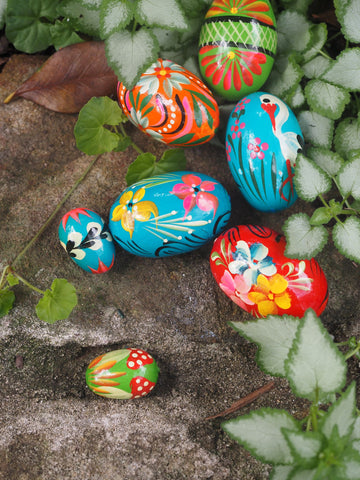Polish Pisanki Easter Eggs

"When I sit down to paint eggs I forget about everything and everyone"
Several years ago B.C. (Before Children), a generous friend Renata welcomed my husband and I to her home. For the first time, we got a proper sense of Polish hospitality and tradition. Renata is very proud of her roots, and she went out of her way for us.
On the Polish food safari-like tour around her lovely Sydney enclave of Liverpool, she guided us to Topsmak Polish Bakery. I have a thing for poppy seeds and doughnuts so the sight of Pacski (jam filled doughnuts); Seromakowiec (poppy-seed cheese cake); and Makowiec (rum infused poppy seed mixed into a giant sausage sweet dough) was sweet heaven. Babka, traditionally served on Easter Sunday, comes in many varieties (as Seinfeld's Jerry and Elaine famously attested to) and crowns this sweetbread tradition on Easter Sunday.
Back Chez Renata, we indulged in our fresh spread of popular Polish sweets and savouries set out on a beautifully handstitched embroidered tablecloth. Polish embroidery is iconic and Polish Australian stitcher Kasia Jacquot is celebrating this beautiful tradition. Her recently launched online classes and beginners kits are helping Aussies take up stitching once again.


Renata 's display of decorative Polish items was intriguing. I remember marvelling at her Pisanki egg collection. We couldn't eat them, of course. These were hand-painted and carved wooden eggs which she had brought back from one her trips back to Poland. Recently, I contacted Renata to ask if I could borrow them to photograph in my garden with my new camera for this very blog piece.


Many cultures celebrate eggs at this time and up to Easter. You'll find versions of Pisanki on the tables and homes of many a Polak, Ukrainian, Romanian, or Grecian, to mention a few. All use varying methods. Not only a characteristic feature of the Easter season, the eggs are part of a long tradition that goes back centuries and one that only stands to continue and grow.


The Egg: Symbol of Life to Come
In pre-Christian times the egg, a symbol of life to come, was adorned with decorations reminiscent of nature’s fertility, such as plant or solar motifs. Eggs were at beginning of spring celebrate the reawakening of nature after its long winter sleep.
Pisanki comes from the verb pisać, or ‘to write’. In an old-school process for making such festive eggs, a special ‘pen’ is used to apply liquid wax to draw emblems and onto the colourless surface of an egg with wax. The egg is then put into a (cold or warm) colour solution. When the eggshell is well and truly locked in the colour, the egg is taken out and heated. The wax melts away revealing the light decorations, the eggshell, underneath a coloured background.

The oldest existing Easter eggs decorated and dyed with this Batik technique – date back to between the 10th and 13th centuries and were found by archaeologists at the site of the former medieval Slavic region of Ostrówek. Natural dyes are not new. Onions have been used for the colour red, rye sprouts for green, beetroot juice for pink, apple-tree bark for yellow.

Duck, chicken or goose eggs can be blown (emptied) or hard boiled. As with Renata's eggs, a multitude of carved and painted varieties also exist as do those styrofoam versions we buy guiltily the night before the kids' Easter Hat Parade.
The pickling technique of a real egg involves first colouring it and, only then, covering it with a wax pattern. Then, it’s placed in a pickling liquid, which cleans off the dye in the spots left uncovered by the wax. After the wax is removed, you’re left with a coloured decoration on a light background. As with the batik technique, this process can be repeated with the same egg and different dyes in order to produce a single, multi-coloured Pisanka.
Kroszonki eggs employ the stylus technique, where they are first dyed then finely carved with delicate floral patterns. Often inscriptions are added.
In parts of Warsaw bright coloured paper making up folky motifs such as roosters and flowers are glued onto blown eggs.

Long before Tinder or The Bachelorette Poland, Pisanki eggs were offered to the eligible bachelors of the village by single girls on Easter Monday - the one and only day of the year they had permission be so brazenly hussey-like.
The eggs also took on superstitious symbolism. A Pisanka, for example, could be placed in the foundations of a building in order to guard it against evil forces. Perhaps someone could have informed the developers of the now empty Opal Towers!
There are a ridiculous amount of ways to decorate your eggs. Heck, you can even cross stitch an ostrich egg! The choice is yours. How would you decorate your pisanki? Do share your photos on Instagram with the hashtag #unfurlyourcreativenature.
Display your eggs, either real or in the chocolate variety, in something special that can be used all year round. Check out Fora's range of quality egg baskets and harvesting trugs. They are sustainably manufactured with FSC (Forestry Stewardship Council) timber and there's even a size for kids.
For me, well it's the K.I. "Kids Interruptus" stage of life right now, and my two little boys like to destroy almost everything in sight. The fragile blown egg batik painting method will have to wait for a few years.





Leave a comment